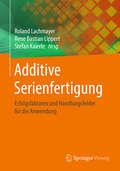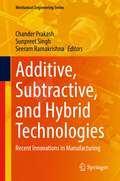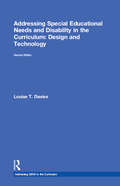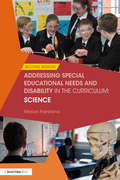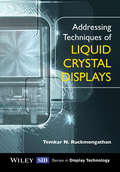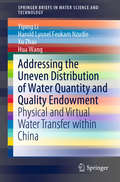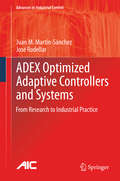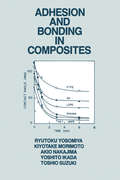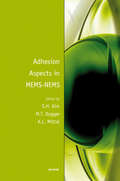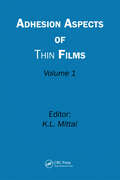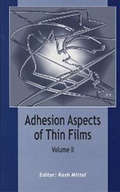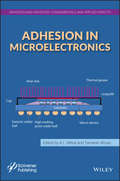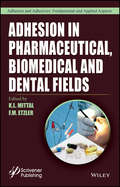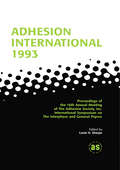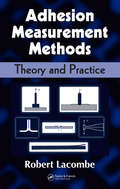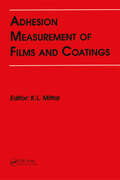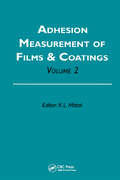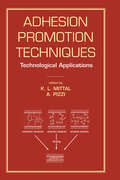- Table View
- List View
Additive Serienfertigung: Erfolgsfaktoren und Handlungsfelder für die Anwendung
by Roland Lachmayer Rene Bastian Lippert Stefan KaierleBei der additiven Fertigung wird anders als bei konventionellen Verfahren ein Bauteil nicht aus einem Block herausgefräst oder in einem Werkzeug gegossen, sondern es wird Schicht für Schicht generiert. Dieses Buch stellt eine Vielzahl verschiedener Aspekte der additiven Fertigung vor und erläutert anhand von Praxisbeispielen die Anwendungen und die Potenziale der Verfahren für eine Serienfertigung: Wo und wie kann die additive Fertigung erfolgreich eingesetzt werden?Die Autoren zeigen vor dem Hintergrund eines ganzheitlichen Entwicklungs- und Fertigungsprozesses mögliche Geschäftsmodelle auf, unter anderem die Fertigung in Microfactories. Leser erfahren, wie sich die Fertigungszeit und -kosten vorhersagen lassen, wie zuverlässig additiv gefertigte Strukturbauteile sind und inwieweit additive Fertigungsverfahren für die Herstellung von Endprodukten geeignet sind.Ferner diskutieren die Autoren, wie Pre- und Post-Prozesse genutzt werden können, um Serienanwendungen zu etablieren und diese iterativ zu verbessern. Neben den Möglichkeiten zur Qualitätssicherung bei der additiven Serienfertigung wird erläutert, wann es sinnvoll sein kann, konventionelle Fertigungsverfahren durch hybride Ansätze zu ergänzen. Die additive Instandsetzung als Alternative zum Entsorgen von verschlissenen Bauteilen wird ebenfalls erörtert. Im Hinblick auf eine Effizienzsteigerung diskutieren die Autoren Sicherheitsaspekte und legen Lösungsansätze bei Problemen im Umgang mit der additiven Serienfertigung dar.
Additive, Subtractive, and Hybrid Technologies: Recent Innovations in Manufacturing (Mechanical Engineering Series)
by Seeram Ramakrishna Chander Prakash Sunpreet SinghThis book provides readers with the comprehensive insights of the recent research breakthroughs in additive, subtractive, and hybrid technologies. Further, the book examines incomparable design and manufacturing independences, as well as strategies to upgrade the product performance characteristics through collaborating additive and subtractive technologies. Indeed, the intrinsic benefits and limitations of both additive and subtractive manufacturing technologies could be merged to obtain appreciable hybridizations. The editorial team members and contributors to Additive, Subtractive, and Hybrid Technologies are highly motivated experts committed to and the advance of hybrid manufacturing technologies.
Addressing Emerging Trends to Support the Future of Criminal Justice: Findings of the Criminal Justice Technology Forecasting Group
by John S. Hollywood Dulani Woods Andrew Lauland Brian A. Jackson Richard SilberglittThe Criminal Justice Technology Forecasting Group (CJTFG) deliberated on the effects that major technology and social trends could have on criminal justice in the next two to five years and identified potential responses. This report captures the results of the group’s meetings and initiatives, presents the emerging trends and highlights of the group’s discussion, and presents the results of analyses to assess connections between the trends.
Addressing Global Challenges and Quality Education: 15th European Conference on Technology Enhanced Learning, EC-TEL 2020, Heidelberg, Germany, September 14–18, 2020, Proceedings (Lecture Notes in Computer Science #12315)
by Maren Scheffel María Jesús Rodríguez-Triana Carlos Alario-Hoyos Inmaculada Arnedillo-Sánchez Sebastian Maximilian DennerleinThis book constitutes the proceedings of the 15th European Conference on Technology Enhanced Learning, EC-TEL 2020, held in Heidelberg, Germany, in September 2020. The 24 research papers and 20 demo and 5 poster papers presented in this volume were carefully reviewed and selected from 91 submissions. The European Conference on Technology-Enhance Learning, which celebrates its 15th anniversary this year, is committed to address global challenges and quality education. The papers deal with the Sustainable Development Goals, particularly SDG 4 and SDG 10, to help to reduce the existing gaps and inequalities between countries and regions from around the world in terms of inclusiveness, equity, access, and quality of education.The chapters: “Designing an Online Self-Assessment for Informed Study Decisions: The User Perspective”; “Living with Learning Difficulties: Two Case Studies Exploring the Relationship Between Emotion and Performance in Students With Learning Difficulties”; “Applying Instructional Design Principles on Augmented Reality Cards for Computer Science Education”; and “Teaching Simulation Literacy With Evacuations - Concept, Technology, and Material for a Novel Approach” are available open access under a Creative Commons Attribution 4.0 International License via link.springer.com. Due to the Corona pandemic EC-TEL 2020 was held as an virtual event.
Addressing Special Educational Needs and Disability in the Curriculum: Design And Technology (Addressing SEND in the Curriculum)
by Louise T. DaviesThe SEND Code of Practice (2015) reinforced the requirement that all teachers must meet the needs of all learners. This topical book provides practical, tried-and-tested strategies and resources that will support teachers in making design and technology lessons accessible and interesting for all pupils, including those with special educational needs. The author draws on a wealth of experience to share her understanding of special educational needs and disabilities and show how the design and technology teacher can reduce or remove any barriers to learning. Offering strategies that are specific to the context of design and technology teaching, this book will enable teachers to: better identify a student’s particular learning requirements; set inclusive design and making assignments which allow all students to participate and succeed; build students’ confidence in using a range of materials and tools; assist with design tasks where pupils take ownership of their work and learning; adapt the classroom environment to meet the needs of pupils; create a mutually supportive classroom which maximises learning opportunities. An invaluable tool for continuing professional development, this text will be essential for design and technology teachers (and their teaching assistants) seeking to include and motivate all pupils in their lessons, regardless of their individual needs. This book will also be of interest to secondary SENCOs, senior management teams and ITT providers. In addition to free online resources, a range of appendices provide design and technology teachers with a variety of pro forma and activity sheets to support effective teaching. This is an essential tool for design and technology teachers and teaching assistants, and will help to deliver successful, inclusive lessons for all pupils.
Addressing Special Educational Needs and Disability in the Curriculum: Science (Addressing SEND in the Curriculum)
by Marion FranklandThe SEND Code of Practice (2015) reinforced the requirement that all teachers must meet the needs of all learners. This topical book provides practical, tried and tested strategies and resources that will support teachers in making science lessons accessible and exciting for all pupils, including those with special needs. The author draws on a wealth of experience to share her understanding of special educational needs and disabilities and show how science teachers can reduce or remove any barriers to learning. Offering strategies that are specific to the context of science teaching, this book will enable teachers to: help all students develop their ‘evidence-gathering’ skills and aid their scientific discovery by involving the use of all of the senses and structuring tasks appropriately; create a supportive environment that maximises learning opportunities; plan the classroom layout and display to enhance learning; use technology to adapt lessons to the needs of individual pupils; successfully train and fully use the support of their teaching assistants. An invaluable tool for continuing professional development, this text will be essential for teachers (and their teaching assistants) seeking guidance specific to teaching science to all pupils, regardless of their individual needs. This book will also be of interest to SENCOs, senior management teams and ITT providers. In addition to free online resources, a range of appendices provide science teachers with a variety of writing frames and activity sheets to support effective teaching. This is an essential tool for science teachers and teaching assistants, and will help to deliver successful, inclusive lessons for all pupils.
Addressing Techniques of Liquid Crystal Displays
by Temkar N. RuckmongathanUnique reference source that can be used from the beginning to end of a design project to aid choosing an appropriate LCD addressing technique for a given application This book will be aimed at design engineers who are likely to embed LCD drivers and controllers in many systems including systems on chip. Such designers face the challenge of making the right choice of an addressing technique that will serve them with best performance at minimal cost and complexity. Readers will be able to learn about various methods available for driving matrix LCDs and the comparisons at the end of each chapter will aid readers to make an informed design choice. The book will address the various driving techniques related to LCDs. Due to the non-linear response of the liquid crystal to external voltages, different driving methods such as passive and active matrix driving can be utilized. The associated theoretical basis of these driving techniques is introduced, and this theoretical analysis is supplemented by information on the implementation of drivers and controllers to link the theory to practice. Written by an experienced research scientist with over 30 years in R&D in this field. Acts as an exhaustive review and comparison of techniques developed for passive-matrix addressing of twisted nematic and super-twisted nematic (STN) LCDs. Discusses the trend towards "High Definition" displays and that a hybrid approach to drive matrix LCDs (combination of active and passive matrix addressing) will be the future of LCD addressing. Contains the author's recent work on Bit-Slice Addressing that is useful for fast responding LCDs, as well as a chapter on driving ferroelectric LCDs Provides an objective comparison that will enable designers to make an informed choice of an addressing technique for a specific application. Includes examples of the practical applications of addressing techniques. Organised in a way that each chapter can be read independently; with the basic knowledge and historical background gained from the introductory chapters, adequate for understanding the techniques that are presented in the remaining chapters making it a self-contained reference.
Addressing the Climate Crisis: Local action in theory and practice
by Candice Howarth Matthew Lane Amanda SlevinThis open access book brings together a collection of cutting-edge insights into how action can and is already being taken against climate change at multiple levels of our societies, amidst growing calls for transformative and inclusive climate action. In an era of increasing recognition regarding climate and ecological breakdown, this book offers hope, inspiration and analyses for multi-level climate action, spanning varied communities, places, spaces, agents and disciplines, demonstrating how the energy and dynamism of local scales are a powerful resource in turning the tide. Interconnected yet conceptually distinct, the book’s three sections span multiple levels of analysis, interrogating diverse perspectives and practices inherent to the vivid tapestry of climate action emerging locally, nationally and internationally. Delivered in collaboration with the UK’s ‘Place-Based Climate Action Network’, chapters are drawn from a wide range of authors with varying backgrounds spread across academia, policy and practice.
Addressing the Climate Crisis in the Indian Himalayas: Can Traditional Ecological Knowledge Help?
by Anwesha Borthakur Pardeep SinghThis book focuses on the traditional ecological knowledge in addressing the current climate crisis in the Indian Himalayas. Local or indigenous people in the Himalayas, through their low-carbon producing lifestyles, contribute very little to the climate crisis. However, at the same time, they bear the brunt of this crisis way more than many others. It is important to learn about their traditional ways of life and the knowledge that they hold regarding ecology and environment. Traditional ecological knowledge and associated belief systems are given increasing attention across the globe in recent times toward addressing some of the grave environmental concerns. Climate change is one such concern. The rising consideration of concepts such as ethnoecology and ethnobotany signifies the scientific, socio-cultural and economic potential of the traditional ecological knowledge systems. It is indisputable that these knowledge systems have the ability to provide important insights towards tackling many present-day environmental distresses including several climate change challenges. In this book, the authors concentrate on such traditional ecological knowledge systems in the Indian Himalayan region and try to figure out their significance in relation to the modern science. Overall, the authors attempt to write a book where the relevance of traditional ecological knowledge systems could be addressed and communicated to a larger audience—both academic scientific and non-academic.
Addressing the Climate in Modern Age's Construction History: Between Architecture and Building Services Engineering (SpringerBriefs in Applied Sciences and Technology)
by Carlo ManfrediThis book sheds light on environmental control in buildings from the 17th century onwards. Even before building services became a hallmark of buildings, in order to address increasing sanitary and comfort needs, pioneering experiences had contributed to improve design skills of professionals. After long being determined by passive features, indoor climate became influenced by installations and plants, representing the most significant shift of paradigm in the modern age’s construction history. This change was not without consequences, and the book presents contributions showing the deep connection between architectural design, comfort requirements and environmental awareness throughout the 19th century. Taking into account the differences between different European countries, the book is a valuable resource for architects, designers and heritage professionals who are interested in environmental design, enabling them to develop a deeper knowledge of heritage in order to address to climate demands, particularly going towards a future in which energy savings and fuel consumption reduction will dictate our behaviour. It includes contributions by leading international experts: Melanie Bauernfeind, Marco Cofani, Lino Vittorio Bozzetto, Emmanuelle Gallo, Alberto Grimoldi, Dean Hawkes, Angelo Giuseppe Landi, Mattias Legnér, Oriel Prizeman, and Henrik Schoenefeldt.
Addressing the Uneven Distribution of Water Quantity and Quality Endowment: Physical and Virtual Water Transfer within China (SpringerBriefs in Water Science and Technology)
by Yiping Li Xu Zhao Hua Wang Harold Lyonel Feukam NzudieThis book presents a selected literature review and case studies for both physical and virtual water transfer. It offers an overview to showcase the interprovincial physical and virtual water transfer within China, and then demonstrates the effects of both approaches in dealing with regional water scarcity; the three cases presented in the Yangtze River Basin demonstrate the role of physical water transfer in improving water quality and restoring water ecosystems; while a Shanghai case highlights the impact of Shanghai’s virtual water import on water quantity and quality stress to other regions. This book promotes systematic approaches combining both virtual and physical water transfer solutions to deal with water quantity and quality issues. The book is intended for senior undergraduates, graduate students, lecturers and researchers in water management.
Adequate Food for All: Culture, Science, and Technology of Food in the 21st Century
by Wilson G. Pond Buford L. Nichols Dan L. BrownFood is the sustenance of life. But while we understand that a secure supply of food has been affected by many factors over the course of history, we do not often allow ourselves to entertain the idea that a lack of adequate food worldwide is a very real and dangerous possibility. While soil degradation, water distribution, climate change, populati
ADEX Optimized Adaptive Controllers and Systems: From Research to Industrial Practice (Advances in Industrial Control)
by Juan M. Martín-Sánchez José RodellarThis book is a simple and didactic account of the developments and practical applications of predictive, adaptive predictive, and optimized adaptive control from a perspective of stability, including the latest methodology of adaptive predictive expert (ADEX) control. ADEX Optimized Adaptive Control Systems is divided into six parts, with exercises and real-time simulations provided for the reader as appropriate. The text begins with the conceptual and intuitive knowledge of the technology and derives the stability conditions to be verified by the driver block and the adaptive mechanism of the optimized adaptive controller to guaranty the desired control performance. The second and third parts present strategic considerations of predictive control and related adaptive systems necessary for the proper design of driver block and adaptive mechanism and thence their technical realization. The authors then proceed to detail the stability theory that supports predictive, adaptive predictive and optimized adaptive control methodologies. Benchmark applications of these methodologies (distillation column and pulp-factory bleaching plant) are treated next with a focus on practical implementation issues. The final part of the book describes ADEX platforms and illustrates their use in the design and implementation of optimized adaptive control systems to three different challenging-to-control industrial processes: waste-water treatment; sulfur recovery; and temperature control of superheated steam in coal-fired power generation. The presentation is completed by a number of appendices containing technical background associated with the main text including a manual for the ADEX COP platform developed by the first author to exploit the capabilities of adaptive predictive control in real plants. ADEX Optimized Adaptive Control Systems provides practicing process control engineers with a multivariable optimal control solution which is adaptive and resistant to perturbation and the effects of noise. Its pedagogical features also facilitate its use as a teaching tool for formal university and Internet-based open-education-type graduate courses in practical optimal adaptive control and for self-study.
Adhesion and Bonding in Composites
by Ryutoku YosomiyaThis book deals with the roles played by the component material interface in composites, with special emphasis on methods used to improve the adhesion and bonding between them. It is helpful for scientists and engineers in the materials field and to engineers working with adhesives or composites.
Adhesion Aspects in MEMS/NEMS
by S. H. Kim M. T. Dugger K. L. MittalPhenomena associated with the adhesion interaction of surfaces have been a critical aspect of micro- and nanosystem development and performance since the first MicroElectroMechanicalSystems(MEMS) were fabricated. These phenomena are ubiquitous in nature and are present in all systems, however MEMS devices are particularly sensitive to their effects
Adhesion Aspects of Thin Films, Volume 1
by K. L. MittalThis book chronicles the proceedings of the First International Symposium on Adhesion Aspects of Thin Films, held in Newark, New Jersey, October 28-29, 1999. Films and coatings are used for a variety of purposes a decorative, protective, functional, etc. a in a host of applications. Irrespective of the intended function or application of a film
Adhesion Aspects of Thin Films, volume 2
by K. L. MittalThis volume documents the proceedings of the International Symposium on Adhesion Aspects of Thin Films (including Adhesion Measurement, and Metallized plastics) held in Orlando, FL, December 15-16, 2003.This volume is divided into three parts. Part 1 a General Papersa ; Part 2 a Metallized Plasticsa ; and Part 3 a Adhesion Measurementa. The top
Adhesion in Foods: Fundamental Principles and Applications
by Amos NussinovitchTo the layman, adhesion is a simple matter of how well two different materials stick together, and adhesion measurements provide some indication of the force required to separate them. However, a more detailed look at adhesion shows that it is a very important feature of food throughout its manufacturing, packaging and storage. Chapters are fully devoted to the fascinating topic of adhesion in foods. Key features of the book include, but are not limited to: definition and nomenclature of adhesion; adhesion mechanisms and measurements; stickiness in various foods and its relation to technological processes; perception of stickiness; hydrocolloids as adhesive agents for foods; adhesion phenomena in coated, battered, breaded and fried foods; electrostatic adhesion in foods; multilayered adhered food products, and adhesion of substances to packaging and cookware. Adhesion in Foods: Fundamental Principles and Applications is dedicated not only to the academic community but also to the broader population of industrialists and experimentalists who will find it to be not only a source of knowledge, but also a launching pad for novel ideas and inventions. In particular, this book is expected to be of interest to personnel involved in food formulation, food scientists, food technologists, industrial chemists and engineers, and those working in product development.
Adhesion in Microelectronics
by K. L. Mittal Tanweer AhsanThis comprehensive book will provide both fundamental and applied aspects of adhesion pertaining to microelectronics in a single and easily accessible source. Among the topics to be covered include; Various theories or mechanisms of adhesion Surface (physical or chemical) characterization of materials as it pertains to adhesion Surface cleaning as it pertains to adhesion Ways to improve adhesion Unraveling of interfacial interactions using an array of pertinent techniques Characterization of interfaces / interphases Polymer-polymer adhesion Metal-polymer adhesion (metallized polymers) Polymer adhesion to various substrates Adhesion of thin films Adhesion of underfills Adhesion of molding compounds Adhesion of different dielectric materials Delamination and reliability issues in packaged devices Interface mechanics and crack propagation Adhesion measurement of thin films and coatings
Adhesion in Pharmaceutical, Biomedical, and Dental Fields
by F. M Etzler K. L. MittalThe phenomenon of adhesion is of cardinal importance in the pharmaceutical, biomedical and dental fields. A few eclectic examples will suffice to underscore the importance/relevance of adhesion in these three areas. For example, the adhesion between powdered solids is of crucial importance in tablet manufacture. The interaction between biodevices (e.g., stents, bio-implants) and body environment dictates the performance of such devices, and there is burgeoning research activity in modifying the surfaces of such implements to render them compatible with bodily components. In the field of dentistry, the modern trend is to shift from retaining of restorative materials by mechanical interlocking to adhesive bonding. This unique book addresses all these three areas in an easily accessible single source. The book contains 15 chapters written by leading experts and is divided into four parts: General Topics; Adhesion in Pharmaceutical Field; Adhesion in Biomedical Field; and Adhesion in Dental Field. The topics covered include: - Theories or mechanisms of adhesion.- Wettability of powders.- Role of surface free energy in tablet strength and powder flow behavior.- Mucoadhesive polymers for drug delivery systems. - Transdermal patches. - Skin adhesion in long-wear cosmetics. - Factors affecting microbial adhesion. - Biofouling and ways to mitigate it. - Adhesion of coatings on surgical tools and bio-implants. - Adhesion in fabrication of microarrays in clinical diagnostics. - Antibacterial polymers for dental adhesives and composites. - Evolution of dental adhesives. - Testing of dental adhesives joints.
Adhesion International 1993
by Louis H. SharpeFirst published in 1996. ADHESION INTERNATIONAL 1993 is a volume of the Proceedings of the 16th Annual Meeting of The Adhesion Society, Inc. Williamsburg, Virginia, USA February 21-26,1993. This meeting featured an International Symposium on The Interphase. Interphases are extremely important in many areas of technology. They are formed when dissimilar materials are joined and they control the properties of adhesive joints, composites, coatings, and microelectronics devices. Considering the importance and scope of phenomena associated with the interphase, it was appropriate to convene such a symposium at the meeting.
Adhesion Measurement Methods: Theory and Practice
by Robert LacombeAdhesion Measurement Methods: Theory and Practice provides practical information on the most important measurement techniques, their unique advantages and disadvantages, and the selection of the proper method for a given application. It includes useful information and formulae on adhesion related matters such as driving force formulae for various m
Adhesion Measurement of Films and Coatings
by K. L. MittalThis book chronicles the proceedings of the International Symposium on Adhesion Measurement of Films and Coatings, held in Boston. The articles in this book were previously published in three special issues of the Journal of Adhesion Science and Technology. Films and coatings are used for a variety of purposes and their adequate adhesion to the und
Adhesion Measurement of Films and Coatings, Volume 2
by K. L. MittalThis book documents the proceedings of the Second International Symposium on Adhesion Measurement of Films and Coatings, held in Newark, NJ, October 25-27, 1999. Since the First Symposium (Boston 1992) there had been considerable activity in devising new, more reliable and more efficient ways to measure adhesion of films and coatings, which resulte
Adhesion Promotion Techniques: Technological Applications
by K. L. Mittal A. PizziPresents the state of the art in improving bond strength between different materials for many manufacturing processes. The text explores up-to-date, high-quality adhesion technologies for a wide variety of materials, explaining current capabilities of adhesion promotion for both students and seasoned researchers. It reviews the suitable chemistry o
